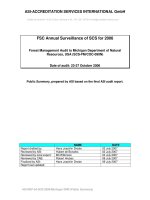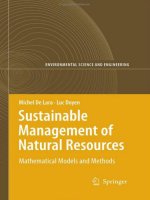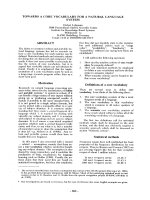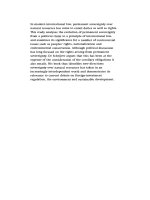NATURAL RESOURCES pot
Bạn đang xem bản rút gọn của tài liệu. Xem và tải ngay bản đầy đủ của tài liệu tại đây (3.3 MB, 192 trang )
Animals
NATURAL RESOURCES
NATURAL RESOURCES
Agriculture
Animals
Energy
Forests
Lands
Minerals
Plants
Water and Atmosphere
ANIMALS
Creatures That Roam the Planet
Julie Kerr Casper, Ph.D.
Animals
Copyright © 2007 by Julie Kerr Casper, Ph.D.
All rights reserved. No part of this book may be reproduced or utilized in any form or by any
means, electronic or mechanical, including photocopying, recording, or by any information storage
or retrieval systems, without permission in writing from the publisher. For information contact:
Chelsea House
An imprint of Infobase Publishing
132 West 31st Street
New York NY 10001
ISBN-10: 0-8160-6353-2
ISBN-13: 978-0-8160-6353-6
L
ibrary of Congress Cataloging-in-Publication Data
Casper, Julie Kerr.
Animals : creatures that roam the planet / Julie Kerr Casper.
p. cm.—(Natural resources)
Includes bibliographical references and index.
ISBN 0-8160-6353-2 (hardcover)
1. Zoology—Juvenile literature. I. Title. II. Series.
QL49.C376 2007
590—dc22
200603022
Chelsea House books are available at special discounts when purchased in bulk quantities for busi-
nesses, associations, institutions, or sales promotions. Please call our Special Sales Department in
New York at (212) 967-8800 or (800) 322-8755.
You can find Chelsea House on the World Wide Web at
Text design by Erik Lindstrom
Cover design by Ben Peterson
Printed in the United States of America
Bang NMSG 10 9 8 7 6 5 4 3 2 1
T
his book is printed on acid-free paper.
All links and Web addresses were checked and verified to be correct at the time of publication.
Because of the dynamic nature of the Web, some addresses and links may have changed since publi-
cation and may no longer be valid.
1
2
3
4
5
6
7
8
9
Wildlife Concepts and Geographical Distribution
Evolution, Adaptation, and Extinction Through Time
Renewable and Nonrenewable Resources
Development and the Resulting Consequences
Uses of Animals
The Importance of Animals
Management of Land, Water, Animals,
and Environment
Conservation of Animal Resources
Conclusion: Future Issues and Trends
Contents
Preface
Acknowledgments
Introduction
vi
x
xi
1
23
42
59
7
9
92
114
13
0
158
Glossary
Further Reading
Index
162
16
8
173
T
he Earth has been blessed with an abundant supply of natural
resources. Natural resources are those elements that exist on
the planet for the use and benefit of all living things. Scientists
commonly divide them down into distinct groups for the purposes of
studying them. These groups include agricultural resources, plants,
animals, energy sources, landscapes, forests, minerals, and water and
atmospheric resources.
One thing we humans have learned is that many of the important
resources we have come to depend on are not renewable. Nonrenewable
means that once a resource is depleted, it is gone forever. The fossil
fuel that gasoline is produced from is an example of a nonrenewable
resource. There is only a finite supply, and once it is used up, that is the
end of it.
While living things such as animals are typically considered renew-
able resources, meaning they can potentially be replenished, animals
hunted to extinction become nonrenewable resources. As we know
from past evidence, the extinctions of the dinosaurs, the woolly mam-
moth,
and the saber-toothed tiger were complete. Sometimes, extinc-
tions like this may be caused by natural factors, such as climate change,
Preface
Natural Resources:
Priceless Gifts from the Earth
Mankind did not weave the web of life.
We are but one strand in it. Whatever we
do to the web, we do to ourselves . . .
All things are bound together.
—Chief Seattle
vi
drought, or flood, but many extinctions are caused by the activities
of humans.
Overhunting caused the extinction of the passenger pigeon, which
was once plentiful throughout North America. The bald eagle was
hunted to the brink of extinction before it became a protected species,
and African elephants are currently threatened with extinction because
they are still being hunted for their ivory tusks. Overhunting is only
one potential threat, though. Humans are also responsible for habitat
loss. When humans change land use and convert an animal’s habitat
to a city, this destroys the animal’s living space and food sources and
promotes its endangerment.
Plants can also be endangered or become extinct. An important
issue facing us today is the destruction of the Earth’s tropical rain
forests. Scientists believe there may be medicinal value in many plant
species that have not been discovered yet. Therefore, destroying a plant
species could be destroying a medical benefit for the future.
Because of human impact and influence all around the Earth, it
is important to understand our natural resources, protect them, use
them wisely, and plan for future generations. The environment—land,
soil, water, plants, minerals, and animals—is a marvelously complex
and dynamic system that often changes in ways too subtle to perceive.
Today, we have enlarged our vision of the landscape with which we
interact. Farmers manage larger units of land, which makes their job
more complex. People travel greater distances more frequently. Even
when they stay at home, they experience and affect a larger share of
the world through electronic communications and economic activi-
ties—and natural resources have made these advancements possible.
The pace of change in our society has accelerated as well. New
technologies are always being developed. Many people no longer spend
all their time focused in one place or using things in traditional ways.
People now move from one place to another and are constantly devel-
oping and using new and different resources.
A sustainable society requires a sustainable environment. Because
of this, we must think of natural resources in new ways. Today, more
vii
PREFACE
than ever, we must dedicate our efforts to conserve the land. We still live
in a beautiful, largely natural world, but that world is quickly changing.
World population growth and our desire to live comfortably are exert-
ing pressures on our soil, air, water, and other natural resources. As we
destroy and fragment natural habitats, we continue to push nonhuman
lif
e into ever-smaller pockets. Today, we run the risk of those places
becoming isolated islands on a domesticated landscape.
In order to be responsible caretakers of the planet, it is important to
realize that we humans have a partnership with the Earth and the other
life that shares the planet with us. This series presents a refreshing and
informative way to view the Earth’s natural resources. Agriculture: The
Food We Grow and Animals We Raise looks at agricultural resources to
see how responsible conservation, such as caring for the soil, will give
us continued food to feed growing populations. Plants: Life From the
Earth examines the multitude of plants that exist and the role they play
in biodiversity. The use of plants in medicines and in other products
that people use every day is also covered.
In Animals: Creatures That Roam the Planet, the series focuses on
the diverse species of animals that live on the planet, including the
important roles they have played in the advancement of civilization.
This book in the series also looks at habitat destruction, exotic species,
animals that are considered in danger of extinction, and how people
can help to keep the environment intact.
Next, in Energy: Powering the Past, Present, and Future, the series
explores the Earth’s energy resources—such as renewable power from
water, ocean energy, solar energy, wind energy, and biofuels; and non-
renewable sources from oil shale, tar sands, and fossil fuels. In addi-
t
ion, the future of energy and high-tech inventions on the horizon are
also explored.
In Lands: Taming the Wilds, the series addresses the land and how
civilizations have been able to tame deserts, mountains, arctic regions,
forests, wetlands, and floodplains. The effects that our actions can
have on the landscape for years to come are also explored. In Forests:
More Than Just Trees, the series examines the Earth’s forested areas and
ANIMALS
viii
how unique and important these areas are to medicine, construction,
recreation, and commercial products. The effects of deforestation, pest
outbreaks, and wildfires—and how these can impact people for genera-
tions to come—are also addressed.
In Minerals: Gifts From the Earth, the bounty of minerals in the
Earth and the discoveries scientists have made about them are exam-
ined. Moreover, this book in the series gives an overview of the critical
part minerals play in many common activities and how they affect our
lives every day.
Finally, in Water and Atmosphere: The Lifeblood of Natural Systems,
the series looks at water and atmospheric resources to find out just how
these resources are the lifeblood of the natural system—from drinking
water, food production, and nutrient storage to recreational values.
Dr
ought, sea-level rise, soil management, coastal development, the
effects of air and water pollution, and deep-sea exploration and what it
holds for the future are also explored.
The reader will learn the wisdom of recycling, reducing, and reus-
ing our natural resources, as well as discover many simple things that
can be done to protect the environment. Practical approaches such
as not leaving the water running while brushing your teeth, turning
the lights off when leaving a room, using reusable cloth bags to trans-
port groceries, building a backyard wildlife refuge, planting a tree,
forming a carpool, or starting a local neighborhood recycling program
are all explored.
Everybody is somebody’s neighbor, and shared responsibility is the
key to a healthy environment. The cheapest—and most effective—con-
servation comes from working with nature. This series presents things
that people can do for the environment now and the important role
w
e all can play for the future. As a wise Native-American saying goes,
“We do not inherit the Earth from our ancestors—we borrow it from
our children.”
ix
PREFACE
W
hile we interact with many animal species every day,
many people are not aware of just how much we depend
on animal life. Animals play a critical role in everyone’s
existence. They provide us with useful products, contribute to medi-
cal advancements, provide valuable services, give us opportunities to
enjoy nature, entertain us, and act as faithful companions.
I hope to instill in you—the reader—an understanding and appre-
ciation of animal life and its role in our environment. Perhaps raising
awareness of animals and all they do and have to offer will spur the
desire to conserve this precious resource in order to avoid the endan-
germent and extinction of species.
I would sincerely like to thank several of the federal government
agencies that study, manage, protect, and preserve animal life—in par-
ticular, the U.S. Fish and Wildlife Service (FWS), the Natural Resources
Conservation Service (NRCS), the National Park Service (NPS), the
U.S. Forest Service (USFS), and the Bureau of Land Management
(BLM) for providing an abundance of resources for information on
this important subject. I would also like to acknowledge and thank the
many universities across the country and their biology departments, as
well as private organizations that diligently strive to protect our pre-
cious animal resources.
Acknowledgments
x
O
ver millions of years, animals have adapted to various envi-
ronments on Earth. Animals exist everywhere—from the
steamy rain forest jungles to the polar ice caps; from the
highest mountains to the deepest oceans. Animal life is crucial. Ani-
mals provide critical links in the food chain as well as in the biogeo-
chemical cycles that help keep the Earth’s environment healthy.
Although animals have evolved over geologic time in response to
the Earth’s constantly changing environments and while the extinc-
tions of certain species are normal, during no other time in the Earth’s
history has the extinction rate climbed as high as it has today. The
reason is simple: human interference. Because of expanding popula-
tions and conversion of the land to urbanization, agriculture, and other
h
uman-based uses, wildlife habitat is being gobbled up at a rapid rate.
As habitat critical to an animal’s survival is lost, eventually so is the
animal itself. Scientists believe that there is a vast amount of animal life
on Earth yet to be discovered, but if humans do not make conservation
of wildlife habitat a priority, we may never know what life existed and
its potential importance to humans.
This volume in the Natural Resources series focuses on the many
aspects that make animals such a vital resource. Chapter 1 looks at the
biosphere, the role of biodiversity, why animals exist where they do,
and how animals have adapted and survived through eons of change
on the planet.
Chapter 2 looks at the fossil record of ancient species and what
important information this gives scientists. It also looks at rates of
extinction and what the true costs are.
Introduction
xi
Chapter 3 examines energy flow through the ecosystem, food webs,
and the delicate balance of biogeochemical cycles.
Chapter 4 addresses development of the land and its effects, the
ne
cessity of responsible land management, and how high-tech com-
puter tools are helping land managers achieve their goals.
Chapter 5 discusses the many uses of animals and how they affect
our lives every day, from products to research, their roles at home and
at work, in nature, in education, in entertainment, and recreation. It
also focuses on how we protect and provide for animals—for their
well-being and welfare.
Chapter 6 looks at the importance of animals and all of the goods
and services they provide to humans and the ways in which they have
greatly improved the quality of our lives.
Chapter 7 addresses the management of the land, water, animals,
and environment as parts of a working system and how each compo-
nent must be present to have a healthy environment. It examines the
causes of endangerment, the truth about poaching, the effects of envi-
ronmental disasters, and laws that protect endangered species.
Chapter 8 presents the successful methods of the conservation,
planning, and restoration needed to keep wildlife flourishing.
Finally, Chapter 9 looks at the future of animals and the actions
each of us can take to ensure not only their survival, but a healthy and
solid future for them so that they will be there for future generations
to enjoy.
ANIMALS
xii
CHAPTER
1
Wildlife COnCepTs
and GeOGraphiCal
di
sTribuTiOn
a
nimals live everywhere on Earth—in every type of climate,
on every type of terrain. About two million species have been
named. Scientists believe there still may be 50 million more to
be discovered. In order to understand the impact that humans have
on biodiversity, it is necessary to know how many species there are,
information about these species, and how the numbers are changing.
This chapter focuses on the biosphere and richness of animal species
on Earth, the role of biodiversity, the existing biomes and habitats,
animal adaptations and mechanisms of survival, animal diversity,
and the future of species.
THE BIOSPHERE
The biosphere is the organization of life. Scientists have recognized
that life can be organized into several different levels of function and
complexity. These functional levels include species, populations, com-
munities, and ecosystems.
1
ANIMALS
2
Species
Species are the different kinds of organisms found on Earth, initially
defined in terms of their appearance. Members of a species look simi-
lar to other members of the species. In addition, members of a species
should be able to interbreed, be physiologically similar, and occupy
similar habitats.
Scientists use taxonomy to name and classify organisms. This is
useful because assumptions can be made about organisms based on
what category they belong to. Likewise, once something is known
about a member of a group, inferences can be made about the group as
a whole. The table below lists types of organisms, how many have been
classified, and how many are estimated still to be discovered.
Viruses 5,000 500,000
Bacteria 4,000 400,000–300 million
Fungi 70,000 1 million–1.5 million
Protozoa 40,000 100,000–200,000
Roundworms 15,000 500,000–1 million
Mollusks 70,000 200,000
Crustaceans 40,000 150,000
Spiders and mites 75,000 750,000–10 million
Insects 950,000 8 million–100 million
Vertebrates 45,000 50,000
(Source: From the PBS program NOVA, www.pbs.org.)
Number of potential species
Organism Number classified yet to be discovered
Organisms Known and Yet to Be Discovered
WILDLIFE CONCEPTS AND GEOGRAPHICAL DISTRIBUTION
3
Scientists classify organisms into seven hierarchical levels of taxa.
They range from most inclusive to the least inclusive, as follows:
Kingdom M
ost inclusive, largest group
Phylum
Class
Order
Family
Genus
Species Least inclusive, smallest group
To illustrate, a human being is classified as follows:
Kingdom A
nimalia
Phylum Chordata
Class Mammalia
Order Primates
Family Hominidae
Genus Homo
Species sapiens
The scientific name of an organism is composed of the genus and
species. For example, in the example of humans, the scientific name is
Homo sapiens.
Population
A population comprises all the individuals of a given species in a spe-
cific area or region at a certain time. Animal populations do contain
genetic variation within themselves and between other populations.
For example, basic genetic characteristics such as hair color, eye color,
or size may differ slightly from individual to individual. In addition,
not all members of the population are equal in their ability to survive
and reproduce so the species continues.
ANIMALS
4
Community
A community refers to all the populations in a specific area or region at
a certain time and involves many interactions among species. They may
interact in their acquisition of food or other environmental resources.
Ecologists believe that a community that has high diversity is more
complex and stable than one that has low diversity. They have found
that the food webs of communities with high diversity are more inter-
connected. Greater interconnectivity makes these systems better able
to deal with disturbance. For instance, if a species is removed, those
species that relied on it for food can turn to other species that occupy
a similar role in the ecosystem.
Ecosystems
Ecosystems (short for “ecological systems”) vary in size. They can be
as small as a pond or as large as the Earth itself. Any group of living
and nonliving things interacting with each other can be considered
an ecosystem. They are units that result from the interactions of abi-
otic, biotic, and cultural components. Because they are systems, they
are a combination of interacting parts. All ecosystems are referred to
as “open systems” because energy and matter are transferred in and
out of them. The largest ecosystem people can relate to is the Earth,
because it constantly converts solar energy into many different kinds
of organic products.
Natural ecosystems are made up of abiotic factors (air, water, rocks,
and energy) and biotic factors (plants, animals, and microorganisms).
The Earth’s biosphere, including the atmosphere (air), hydrosphere
(water), and lithosphere (land), is a working system of living things and
their physical and chemical environments.
Changes in any component of ecosystems (such as temperature,
nutrient availability, and population density) will result in dynamic
changes to the nature of these systems. An example of this is a forest
fire. A fire changes the ecosystem because it removes large trees, destroys
the shrubs and mosses that covered the forest floor, and destroys the
nutrients that had been stored in all the biomass (living matter, such as
WILDLIFE CONCEPTS AND GEOGRAPHICAL DISTRIBUTION
5
vegetation). Once the area recovers from the burn, the community that
was once mature trees is now a community of grasses.
THE ROLE OF BIODIVERSITY
Biodiversity is the term used to describe the variety of life on Earth. It
encompasses all the animals, plants, and microorganisms that exist on
the planet, the genetic variety within these species, and the variety of
ecosystems they inhabit. Biodiversity can exist at three levels:
The concept of a nested ecosystem. Ecosystems can be many sizes, ranging
from a broad area of land to a single bird.
ANIMALS
6
• Species diversity—this is the variety of species of animals,
plants, and microorganisms on Earth or in a given area
capable of reproducing fertile offspring.
•
Genetic diversity—this is the variety of genetic
characteristics found within a species and among different
species. An example of genetic diversity in humans is the
variation in hair and eye color, height, and facial
appearance.
•
Ecosystem diversity—this is the variety of natural systems
found in a region, a continent, or on the planet. A
mountain, a prairie, and a wetland are examples of three
different types of ecosystems.
Within each ecosystem there are habitats that may also vary in size.
A habitat is a place where a population lives in a community of living
things that interact with the nonliving world around it to form an eco-
system. Most animals are only adapted to live in one or two habitats.
For example, a bear can be seen in a temperate forest or alpine area,
but not in a wetland or desert. Likewise, saltwater fish—such as the
shark—could not live in the arctic or a freshwater lake. Some animals
migrate in the spring and migrate again in the fall in search of warmer
habitats with an abundance of food, such as humpback whales and
many species of birds.
The habitat must supply the needs of the organisms, such as food,
water, appropriate temperature, oxygen, and minerals. If a population’s
needs are not met, it will move to a better habitat. Two different
populations cannot occupy the same niche at the same time, however,
because they would be competing against each other for survival.
Because of this, the processes of competition, predation, cooperation,
and symbiosis occur.
A habitat is the place where many species live naturally. Billions
of different things live together in a habitat. Some beings are so tiny,
they can only be seen with a microscope. Others, like whales, horses,
or giraffes, are huge. All species play a significant role in making the
WILDLIFE CONCEPTS AND GEOGRAPHICAL DISTRIBUTION
7
habitat a healthy place to live. Several populations can share a habitat
and can coexist with each other. For example, in a coral reef, many fish
coexist. Likewise, in a rain forest, a multitude of populations not only
coexist, but distinct populations coexist in multiple levels of the rain
forest. For example, in the higher canopies, several species of parrots
may occupy the habitat.
Biodiversity is important in a habitat for several reasons. The dif-
ferent populations fill specific positions in the food chain. If a com-
ponent in the food chain—plant or animal—disappears, it upsets the
ecological balance of the habitat and can ultimately destroy it.
The Earth’s biodiversity has been in a constant state of change
for as long as life has existed. Periodic natural events, such as meteor
impacts, volcanoes, glaciers, climate change, drought, fire, and flood-
ing have disturbed ecosystems and led to the reduction or extinction
of species, reducing biodiversity. As civilization has developed, humans
have had an important impact. Several human activities directly or
indirectly threaten biodiversity.
For example, humans often disturb natural ecosystems. Because
each ecosystem consists of a community of animals, plants, soil, miner-
als, water, and air, each component of the system fills a special role. It is
a delicate balance, and humans have the ability to destroy this natural
balance. When the balance is disrupted, this can trigger a multitude of
other disruptions because all the components are tied together, thereby
threatening the health and existence of the entire ecosystem.
Humans have an adverse impact when they pollute the environ-
ment. Human activity can pollute the water, air, or soil and harm
biodiversity. When humans introduce nonnative species of plants and
animals (plants and animals that don’t normally live in a particular
habitat), it also disrupts biodiversity and may have a negative impact
because it causes competition with native species for survival.
Destruction of habitat is another way humans can adversely affect
biodiversity. When natural lands—such as deserts, wetlands, or grass-
lands—are converted to urban areas or farms, it leads to the loss of
natural plant and animal habitats.
ANIMALS
8
Overexploitation is another problem. When humans hunt animals
or use animals for food, raw materials for industry, or for their fur, it
can threaten the continuation of species and even lead to extinction.
Biodiversity is very important. Everything that lives in an ecosys-
tem is part of the web of life—including humans. Maintaining a wide
diversity of species in each ecosystem is necessary to preserve the web
of life that connects and supports all living things.
The more biodiversity there is—both within species and between
species—the greater chance of that habitat surviving. Even if some
species are destroyed, chances are good that others will survive when
biodiversity is high. That is why biologists often measure the health of
a habitat based on its biodiversity.
BIOMES OF THE EARTH
Descriptions of the environment, such as temperature and rainfall,
are used to group habitats together. Habitats of similar climate and
vegetation are called biomes. In different parts of the world, the
s
ame biome may contain different species, but similar life-forms
can always be identified. For example, a pine tree is a dominant
form in a temperate forest regardless of where the temperate forest is
located. The Earth’s biomes can be classified in several ways, includ-
ing the following:
• D
esert
• Scrubland
• Tundra
• Boreal forest (taiga)
• Temperate grassland
• Temperate forest
• Savanna
• Tropical rain forest
• Mountain
• Aquatic
WILDLIFE CONCEPTS AND GEOGRAPHICAL DISTRIBUTION
9
Biomes are extremely important. They have changed and moved
many times during the history of life on Earth. More recently, human
activities have drastically altered these communities.
Desert
Deserts cover more than one-third of the world’s land. They are some
of the hottest, driest places on Earth. Temperatures can be as high as
120°F (50°C). Deserts can also be cold. Some deserts can drop to tem-
peratures of -4°F (-20°C). The little rain that falls evaporates quickly.
Even though the conditions are harsh, deserts provide a home to many
animals. Some desert animals cope with the sun’s heat by burrowing
beneath the sand, because sand stays cooler than the desert surface.
Some mammals—such as the naked mole rat—hardly ever leave
Major biomes of the Earth.
ANIMALS
10
their burrows. Some animals avoid the scorching sun by only coming
out at dawn and dusk, such as the North American kangaroo rat, the
American ground squirrel, and the North African jerboa.
Scrubland
Scrublands are places with hot summers and cool, moist winters.
Because of the hot, dry summers, trees don’t grow very tall. Animals
in these regions must be able to adapt to many different conditions
because they are generally located near oceans.
Tundra and Polar
These regions—located at the far northern and southern latitudes—are
characterized by long, dark winters. Because they are located at the
The ecological regions of North America.
WILDLIFE CONCEPTS AND GEOGRAPHICAL DISTRIBUTION
11
Earth’s poles, the sun never rises far above the horizon. Beyond the
ice-covered Arctic, however, is the tundra, which supports a fairly large
amount of animal life. Each summer, the vegetation that appears dur-
ing the short growing season attracts many birds and other animals.
Boreal Forest
The boreal forest—also called the taiga—is an extremely large biome
covering 6,800 miles (4,506 kilometers) across the northern hemisphere.
It also exists high on mountain ranges such as the Rocky Mountains
and Appalachians in the United States and the Alps in Europe.
The boreal forest is characterized by a cold climate, scarce rainfall,
and a short growing season. When boreal forests are located in the
interior portions of continents, the temperatures can get colder than
Examples of ecosystems: (a) Mountain; (b) Island. The ecosystem determines
which animals can survive in that environment, such as the caribou that lives
in the Arctic regions. Different wildlife, such as parrots, live in coastal and
tropical areas. If an animal cannot adapt to the environment, it will not survive.
(a, courtesy of the U.S. Fish & Wildlife Service, Dean Biggins; b, Nature’s
Images, Julie A. Kerr)
a b
ANIMALS
12
the polar regions further north. Interior continental locations are
colder because they do not have the benefit of nearby warmer ocean
air to modify the climate. Frost covers the areas most of the year, which
causes much of the ground to be permanently covered in water because
the frost keeps the water from being able to drain away. The severity of
winter limits the diversity of animal life. Not only are physical condi-
tions harsh, but there often is little food.
Due to the harsh conditions, many of the animals do not live in
the boreal forest the entire year. Birds only migrate into the area dur-
ing the summer, moving south to a warmer climate for the rest of the
y
ear. Animals that do live there year-round have adapted to life in this
harsh climate.
Insects, such as mosquitoes, gnats, and midges, are abundant dur-
ing spring and summer, serving as food for migratory birds.
Temperate Grassland
The grasslands of Asia are called steppes, those of South America are
called pampas and campos, and those of North America are called prai-
ries. Many animals live in these areas. Different animals are found in dif-
ferent parts of the grasslands based on the annual rainfall of the area.
The North American prairie is divided into three categories: (1)
short grass, where grass stays below 20 inches (51 centimeters) tall;
(2) mixed grass, where grass ranges from 20 to 60 inches (51–152 cm)
tall; and (3) eastern tall grass, where grass can grow as high as 10 feet
(3 meters).
The Asian steppe is divided into an eastern and western range. The
eastern steppe is higher and drier. It can also be divided into western
forest steppe (this area contains pine, oak, and birch trees), open steppe
(where trees are scarce), and southern semidesert (where desert vegeta-
tion grows).
The various landforms—such as marshes, streams, rocky slopes,
and rock outcrops—provide niches for different kinds of animals.
Muskrats and water snakes are found in water bodies such as creeks
and rivers; frogs, crickets, and water bugs are found in the shallow tide









